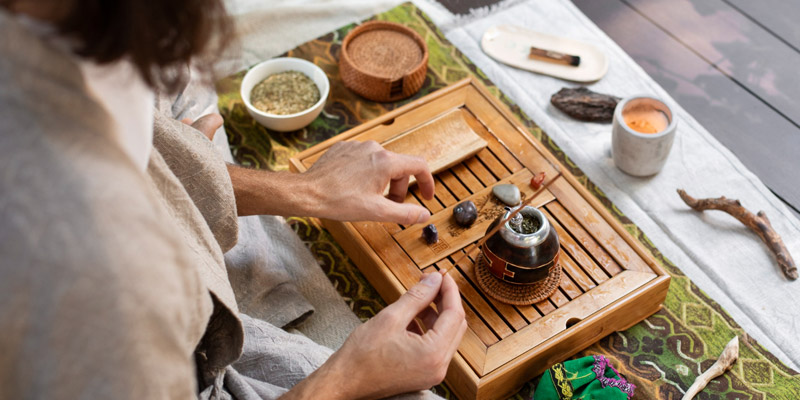
Sciatica is a common condition characterized by pain radiating along the path of the sciatic nerve, which runs from the lower back through the hips and down each leg. It can be a debilitating condition, causing discomfort and limiting mobility for those who suffer from it. While there are various treatment options available, Ayurveda offers the best Ayurvedic treatment for sciatica, aiming to provide relief and promote the cure for sciatica naturally.
Introduction to Sciatica
It refers to the pain caused by the compression or irritation of the sciatic nerve. The most common cause of sciatica is a herniated disc in the lumbar spine, which puts pressure on the nerve roots. Other causes include spinal stenosis, degenerative disc disease, spondylolisthesis, muscle spasms, and even pregnancy.
Ayurveda for Sciatica

Ayurveda, an ancient Indian system of medicine, emphasizes the balance of mind, body, and spirit for overall well-being. According to Ayurveda, sciatica is primarily caused by an imbalance in the Vata dosha, which governs movement and nerve functions in the body. Ayurvedic treatments aim to alleviate the symptoms and promote the natural cure for sciatica by addressing this imbalance and restoring harmony.
Causes of Sciatica

It can be caused by various factors, including:
Herniated disc: When the inner core of a spinal disc protrudes and presses on the nerve roots.
Spinal stenosis: The narrowing of the spinal canal, leading to compression of the nerves.
Degenerative disc disease: Wear and tear of the spinal discs over time.
Spondylolisthesis: The slippage of one vertebra over another, causing nerve compression.
Muscle spasms: Tightening or contractions of muscles in the lower back or buttocks.
Pregnancy: Pressure on the sciatic nerve due to the growing uterus.
Ayurvedic Treatments for Sciatica

Ayurvedic treatments aim to alleviate pain, reduce inflammation, and strengthen the nervous system. These treatments are natural, safe, and effective. The best ayurvedic treatment for sciatica includes a combination of therapies tailored to individual needs.
Here are the commonly used treatments.
Panchakarma Therapy for Sciatica
Panchakarma therapy is one of the best ayurvedic treatments for sciatica. It involves a series of therapeutic procedures that help eliminate toxins from the body and restore balance to the doshas. The therapy includes:
Abhyanga (Ayurvedic Massage): A full-body massage using warm herbal oils to promote relaxation, improve circulation, and reduce pain.
Swedana (Herbal Steam Therapy): Application of herbal steam to the affected area to alleviate pain, reduce inflammation, and relax the muscles.
Basti (Enema Therapy): Medicated enemas are used to nourish the affected area, reduce inflammation, and relieve pain.
Herbal Remedies for Sciatica
When it comes to finding natural solutions, herbal remedies stand out as a beacon of hope. Harnessing the power of nature, these botanical wonders offer effective relief from pain and promote the cure for sciatica naturally.
Let’s delve into the realm of herbal remedies and explore their remarkable benefits in treating sciatica:
Turmeric: The Golden Spice
- Curcumin, the active compound in turmeric, exhibits potent anti-inflammatory properties that help reduce pain and inflammation.
- Turmeric also acts as a natural analgesic, providing relief from the discomfort caused by sciatic nerve compression.
- Adding turmeric to your diet or taking curcumin supplements can be beneficial for managing symptoms.
Ashwagandha: The Stress Buster
- Ashwagandha is an adaptogenic herb known for its ability to combat stress and reduce cortisol levels, which can contribute to sciatica pain.
- This herb helps calm the nervous system, promoting relaxation and reducing muscle tension.
- Incorporating ashwagandha into your daily routine through supplements or herbal preparations can aid in managing symptoms.
Shallaki: The Resin of Relief
- Shallaki, also known as Boswellia, possesses potent anti-inflammatory properties that help alleviate pain and reduce swelling.
- Its active compounds, boswellic acids, target the underlying inflammation and support the cure for sciatica naturally.
- Using shallaki in the form of capsules, extracts, or topical applications can provide significant relief from symptoms.
Guggulu: The Joint Rejuvenator
- Guggulu, derived from the resin of the Commiphora mukul tree, possesses powerful anti-inflammatory and analgesic properties.
- It helps reduce pain, inflammation, and stiffness associated by improving blood circulation and supporting joint health.
- Guggulu can be taken internally as capsules or used externally as part of an herbal oil formulation for a soothing massage.
Nirgundi: The Nerve Nurturer
- Nirgundi, also known as Vitex negundo, is a herb renowned for its analgesic and anti-inflammatory properties.
- It helps alleviate pain by reducing nerve irritation and improving nerve function.
- Applying nirgundi oil topically or taking it in the form of capsules or extracts can provide targeted relief to the affected area.
Ayurvedic Lifestyle Recommendations

Along with specific treatments, adopting certain lifestyle recommendations can enhance the effectiveness of ayurvedic treatment for sciatica. These lifestyle recommendations include:
- Maintain a Regular Routine: Establishing a regular daily routine can help support overall well-being and reduce the symptoms. Wake up and go to bed at consistent times, and schedule meals, exercise, and relaxation activities accordingly.
- Practice Stress Management: Chronic stress can exacerbate the symptoms. Incorporate stress management techniques such as meditation, deep breathing exercises, and mindfulness practices to reduce stress levels and promote relaxation.
- Keep the Affected Area Warm: Sciatica pain often worsens in cold weather or when the affected area is exposed to cold temperatures. Keep the lower back and legs warm by wearing appropriate clothing and using heating pads or warm compresses.
- Avoid Prolonged Sitting or Standing: Sitting or standing for extended periods can put pressure on the sciatic nerve. Take regular breaks to stretch and move around, and use ergonomic supports like cushions or standing mats to reduce strain on the back.
- Follow a Vata-Pacifying Diet: Ayurveda suggests consuming warm, nourishing foods that pacify the Vata dosha. Include cooked vegetables, whole grains, healthy fats, and warming spices in your diet. Avoid cold, raw, or processed foods that may aggravate Vata.
Yoga and Exercise for Sciatica Relief

Yoga and exercise are important components of the Ayurvedic treatment for sciatica.
- Gentle Stretching: Engage in gentle stretching exercises that target the muscles surrounding the sciatic nerve. Focus on stretches for the hamstrings, glutes, lower back, and hips. Perform these stretches regularly to improve flexibility and alleviate pain.
- Yoga Asanas: Practice specific yoga asanas that are beneficial for relieving symptoms. Poses such as Child’s Pose (Balasana), Downward-Facing Dog (Adho Mukha Svanasana), and Cat-Cow Stretch (Marjariasana-Bitilasana) can help stretch and strengthen the back and leg muscles.
- Core Strengthening: Strengthening the core muscles can provide support to the lower back and reduce strain on the sciatic nerve. Include exercises that target the abdominal muscles, such as planks, bridges, and pelvic tilts, in your exercise routine.
- Low-Impact Cardiovascular Activities: Engaging in low-impact cardiovascular activities like swimming or walking can improve blood circulation and promote the cure for sciatica without putting excessive stress on the spine and affected areas.
- Consult a Qualified Instructor: If you’re new to yoga or exercise, it’s recommended to seek guidance from a qualified instructor who can tailor a program to your specific needs and ensure proper form and technique.
Diet and Nutrition for Sciatica
- Anti-Inflammatory Foods: Incorporate foods with anti-inflammatory properties into your diet to help reduce inflammation and alleviate sciatica pain. Examples include turmeric, ginger, garlic, leafy greens, and berries.
- Magnesium-Rich Foods: Magnesium plays a vital role in nerve function and muscle relaxation. Consume foods rich in magnesium, such as spinach, almonds, avocados, and bananas, to support nerve health and reduce muscle tension.
- Hydration: Drink an adequate amount of water throughout the day to keep the body hydrated and support the overall health of the spinal discs and nerves.
- Avoid Trigger Foods: Identify and avoid foods that may trigger inflammation or worsen symptoms. These can vary from person to person, but common triggers include processed foods, sugary snacks, and high-fat foods.
- Consult with a Nutritionist: For personalized dietary guidance, consider consulting with a qualified nutritionist who can create a tailored nutrition plan to support your specific needs and naturally promote the cure for sciatica.
Preventive Measures for Sciatica
Preventive measures can help reduce the risk of developing sciatica or prevent its recurrence. Some preventive measures to consider include:
- Practicing good posture while sitting, standing, or lifting heavy objects.
Engaging in regular exercise to strengthen the core muscles and support the spine. - Using proper body mechanics when lifting or carrying heavy objects.
Taking breaks and avoiding prolonged periods of sitting or standing. - Managing stress levels to prevent muscle tension and inflammation.
Benefits of Ayurveda for Sciatica
Ayurveda offers several benefits for individuals suffering from sciatica:
- Natural and Holistic Approach: Ayurveda treats the root cause, promoting overall well-being by restoring balance in the body and mind.
- Alleviation of Pain and Inflammation: Ayurvedic treatments reduce pain and inflammation using natural remedies, minimizing reliance on medications.
- Improved Quality of Life: Ayurveda addresses imbalances, enhances mobility, and restores daily activities, improving overall quality of life.
- Personalized Treatment: Ayurveda tailors treatments to individual needs, considering unique constitutions, imbalances, and specific symptoms.
Conclusion
Sciatica can be a challenging condition to manage, but Ayurveda offers effective solutions with its best Ayurvedic treatment for sciatica. By incorporating natural remedies, adopting a healthy lifestyle, and seeking professional guidance, individuals can find relief from pain, reduce inflammation, and promote healing. Ayurveda provides a holistic approach that addresses the root cause of sciatica, aiming to restore balance and improve overall well-being.
FAQs
What is the best ayurvedic treatment for sciatica?
The best ayurvedic treatment for sciatica includes a combination of therapies such as Panchakarma, herbal remedies, lifestyle modifications, and specific exercises or yoga asanas.
Can Ayurveda cure sciatica completely?
Ayurveda aims to alleviate sciatica symptoms, reduce pain, and promote healing. The extent of improvement and healing varies from person to person.
Are Ayurvedic treatments safe for everyone?
Ayurvedic treatments are generally safe, but it is important to consult with an experienced Ayurvedic practitioner, especially if you have any underlying health conditions or are taking medications.
Is surgery necessary for sciatica, or can it be treated with Ayurveda alone?
In most cases, sciatica can be effectively managed with Ayurvedic treatments, lifestyle modifications, and other conservative measures. Surgery is typically considered when there is severe nerve compression or when other treatments have not provided sufficient relief.




